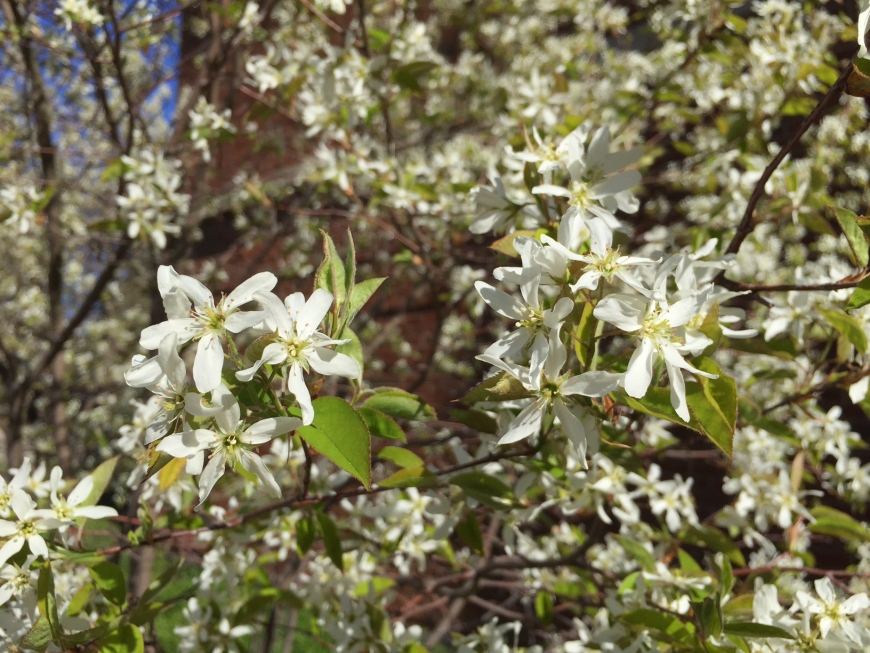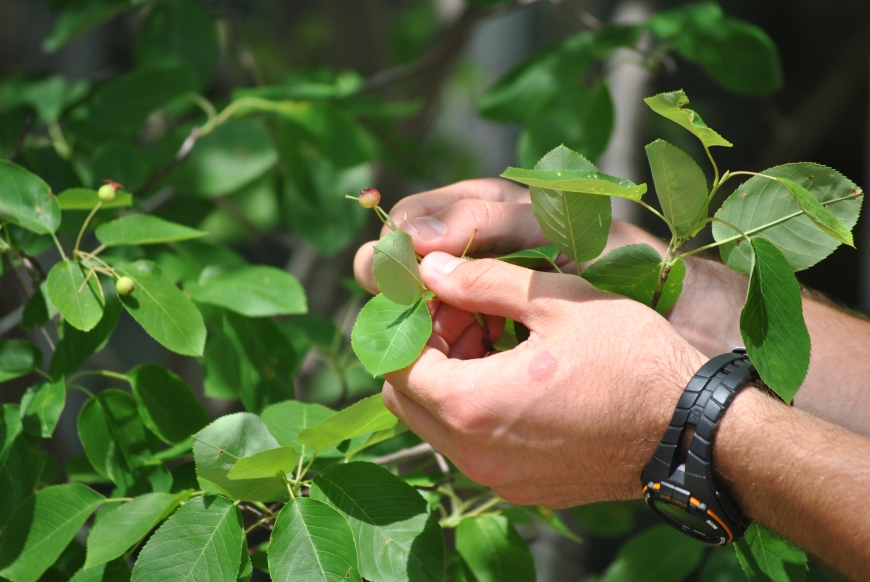

Juneberry flowers in Canton, May 6th 2016.
Unripe juneberry leaves and fruit, June 2015.


Juneberry: An Early Bloomer
Another regional attraction has just opened, and for the next few weeks you can see the show at innumerable open-air venues across the Northeast. The performance is free, although only matinees are available.
The new event is the blossoming of a widespread, though strangely little-known, early-flowering plant. It is either a small tree or a shrub, depending on who you ask, which makes me wonder if it’s hiding something. In fact, this thing has more aliases than one of America’s Most Wanted. Variously known as serviceberry, shadbush, shadwood, shadblow, Saskatoon, juneberry and wild-plum, it is a small-to-medium size tree that also answers to Amelanchier Canadensis, its botanical name. Of those options, I prefer juneberry even though its fruit may ripen in early July in northern New York State.
It’s the first native woody plant to produce conspicuous flowers, and its white blossoms can be seen on roadsides, in fencerows and on forest edges throughout our area right now. The smooth, gray-silver bark is attractive in its own right. Depending on conditions, juneberries may grow as a multi-stem clump, but more often develop as single-trunk trees reaching 25 to 40 feet tall. Not only are its early blossoms an aesthetic treat, they’re advertising the location of a source of berries that boast more nutrient value than almost any other native fruit.
Juneberries are often overlooked as a food source, partly because birds may beat us to the punch, and partly because juneberries grow tall enough that the fruit is sometimes out of reach. Because juneberries have less moisture than blueberries, they’re slightly higher in protein and carbohydrates, making them a great food for athletes and other active people.
The soft, dark purple berries have twice as much potassium as blueberries in addition to large amounts of magnesium and phosphorous. They’re a good source of iron, too, having almost twice as much as blueberries. Juneberries also have plenty of vitamin C, thiamin, riboflavin, pantothenic acid, vitamin B-6, vitamin A and vitamin E.
Juneberries make an attractive landscape plant, and can be used to entice songbirds like cedar waxwings to your yard. Amelanchier alnifolia, a species from the Northern Plains closely related to our northeastern A. canadensis, is better for home use, as it does not grow as tall, so the fruit will always be within reach. It can tolerate a wide range of site conditions and will thrive even in poor soils. Full sun is a must, however. Another plus is that juneberry foliage turns a remarkable salmon-pink in the fall, adding to its value as a landscape shrub.
The berries are delectable fresh, and make excellent pies. They’re especially good for freezing, as they make excellent, nutrient-packed smoothies year-round. It’s helpful to freeze them first on cookie sheets, and then transfer them to bulk containers. That way they don’t form the kind of monolithic juneberry glacier that requires a chisel, adult supervision and a first-aid kit to break off a chunk.
Native peoples across northern North America valued juneberries, and European settlers followed their example. You too can take advantage of this under-appreciated wild fruit. This is a great time to make note of the location of juneberry plants for harvesting this summer. For more juicy juneberry tidbits from Cornell, visit www.juneberries.org or contact your local Cornell Cooperative Extension office.

